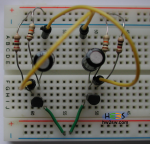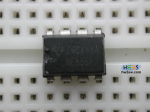
As promised last time we're here completing the multi-vibrator astable cycle with a test on breadboard.
Here beside a from-top photo of a base pull-up set (i.e. resistors go from positive supply to bases. Pull-downs start from ground).
Very quickly: some screenshots from oscilloscope will reveal what indeed we've discovered with an on-chart look.
The present post doesn't cover deep technical details but tends to give a consistent view about what happens with a real astable circuit.
Jelly-beans parts are used so that it's easy and cheap for everybody to replicate it in a quick.
In this case the bjts are two npn BC548C, very common low power amplifying transistors here used in switch mode; then two 1k resistors (1/4 W) going from the positive rail to the collectors; other two 10k resistors (1/4 W) for the bases and finally the 100μF 25V electrolytic caps which go from the bases to the opposite collectors through the yellow wires.
Tests were performed with two values of power supply: 5V and 13.5V.



